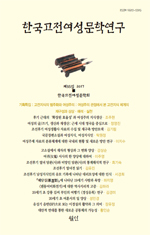- 영문명
- An Aspect of the ‘Ideal Wife’ in 19th Century Novels : A Study on the ‘Mrs. Wang’ of Oksugi(玉樹記)
- 발행기관
- 한국고전여성문학회
- 저자명
- 박혜인(Heain Park)
- 간행물 정보
- 『한국고전여성문학연구』제50권, 259~288쪽, 전체 30쪽
- 주제분류
- 인문학 > 문학
- 파일형태
- 발행일자
- 2025.06.30

국문 초록
본고는 고전 소설 속 ‘이상적 아내’과 관련한 당시 향유층의 시각을 파악하는 데 목적이 있다. 이를 위해 본고는 19세기 사대부 남성 심능숙이 쓴 한문장편소설 <옥수기>의 여성 인물 중 왕여란의 인물 형상화 과정에서 보이는 모순점에 주목하였다.
<옥수기>에서는 다양한 남녀의 결연 과정이 등장하면서 그와 관련된 여성 인물들의 여러 개성이 드러난다. 그중에서 왕여란은 가유진의 3처 중 하나로 주인공 가문의 조력자로 등장하는 상서 왕지장의 딸이자 전형적인 규방 여성이다. 그러나 그녀는 동시에 이와는 전혀 배치되는 특질이 주어지면서 앞서의 이미지와 충돌을 일으킨다.
왕여란은 몸에서 향내가 난다는 섹슈얼리티적 매력이 특징으로 부각되는데, 이는 기생이나 첩이 가진 성적 매력과 관련이 있다는 점에서 상층계급의 전형적인 규방 여성이자 정실부인인 왕여란의 이미지와 충돌을 일으킨다. 또한 그녀의 집안은 황실의 외척으로, 이는 그녀와 가유진과의 결연이 늑혼 갈등으로 이어지게 되는 원인이 된다. 그녀는 실제 작중 행적과 달리, 천자를 힘입어 사모하는 남성을 얻으려 하는 ‘음녀’ 이미지를 함께 갖게 된다.
<옥수기> 속 왕여란이라는 인물은 기존 소설에서 음녀 혹은 악녀의 특질들을 수용하면서도, 성적 매력을 가진, 권력자의 딸이라는 요소만을 취해 긍정적 인물로 전유하고 있다. 왕여란 캐릭터에서 보여준, 기존 부정적 여성상에 대한 변화된 태도는 당대의 문화적 사회적 변화와도 무관하지 않아 보인다. 특히 18-19세기 남성 사대부 중심으로 향유된 다량의 세정소설이 이러한 변화에 영향을 주었을 것으로 보인다. 이른바 금병매류의 소설들은 처첩의 위계와 질서가 잘 드러나지 않으며 반금련과 같이 섹슈얼리티적 매력이 전면에 드러나는 음녀가 주요 인물로 등장하는 등 기존의 유가적 틀에서 벗어난 세속적 요소가 부각되어 있다. 이에 따라 19세기 소설 또한 색(色)에 대한 관심이 커지고 윤리, 도덕적 문제에 크게 구애받지 않는 모습을 보여주고 있다. 이러한 변모 속에서 춘향과 같이 ‘기생이자 열녀’인 여성 인물이 등장하기도 한다.
<옥수기>의 왕여란 또한 열녀인 화려소, 여성영웅인 진월아와 함께 등장하는 가유진의 정실부인 중 하나이다. 즉 결연에 ‘가합(可合)한’ 또 다른 여성상이라 할 수 있다. 이러한 왕여란 캐릭터는 처/첩, 덕/색의 분리가 흐릿해진 19세기 ‘이상적 아내상’ 중 한 양상으로 볼 수 있을 것이다.
영문 초록
The purpose of this study is to find out the perspective of the readers of the time on the 'ideal wife images' in classical novels in the 19th century. To this end, he paid attention to the contradictions seen in the process of shaping Wang Yeo-ran's character among female characters in the 19th-century Chinese novel Oksugi(玉樹記) written by Shim Neung-sook, a male student in the noble class.
In Oksugi(玉樹記), the personality of various female characters is revealed as the process of various male and female relationships appears. Among them, Wang Yeo-ran is one of the three wives of Ga Yu-jin, the daughter of Wang Ji-jang, the assistant of the main character family, and a typical upper-class woman. However, she has characteristics that are completely opposite to this position.
Wang Yeo-ran is characterized by the sexuality of having a scent from the body, which is related to the sexuality of a gisaeng(妓生) or concubine. Her characteristics are upper-class and a woman from Kyubang(閨房) and a woman from a wife are usually invisible. Wang Yeo-ran's family is also a relative of the imperial family, and the power of her family causes controversy over forced marriage in her ties to Ga Yu-jin. In the process of marriage, the image of a evil woman who tries to marry a man through the power of the emperor continues to be summoned, but she is also a helper.
The character Wang Yeo-ran in Oksugi(玉樹記) accepts the characteristics of a lewd woman or a wicked woman from the previous novel, but takes only the element of a daughter of a powerful person with sexuality and converts her into a positive character. The change in attitude toward negative female images shown in the character Wang Yeo-ran is also related to cultural and social changes at the time. In particular, a large amount of Chinese ‘Novels of Manners(世情小說)’ read by male aristocrats in the 18th and 19th centuries would have influenced this change. ‘Novels of Manners(世情小說)’ of the same kind as “JinpingMei(金甁梅)” do not reveal the hierarchical order between a crony wife and a concubine, and a lewd woman, like Pan Jinlian, who reveals her sexuality to the front, appears as a major character. Secular elements that deviate from the existing Confucian framework are highlighted. Accordingly, 19th-century novels also show a growing interest in women's beauty and are not very bound by ethical and moral issues. In this transformation, female characters who are parasitic and demonstrative women such as ‘Chunhyang‘ also appear.
Wang Yeo-ran of Oksugi(玉樹記) is also one of Ga Yu-jin's crony wives who appear with the exemplary woman, Goranso, and the female hero, Jin Wol-ah, and exists as another ideal wife to marry. This Wang Yeo-ran character can be seen as one of the 19th-century 'ideal wife images' that do not separate well between wife and concubine, morality and beauty.
목차
1. 서론
2. 왕여란 인물 형상 : 음녀 특질의 전유
3. 세정소설의 수용과 이상적 아내상의 변모
4. 결론
키워드
해당간행물 수록 논문
참고문헌
최근 이용한 논문
교보eBook 첫 방문을 환영 합니다!

신규가입 혜택 지급이 완료 되었습니다.
바로 사용 가능한 교보e캐시 1,000원 (유효기간 7일)
지금 바로 교보eBook의 다양한 콘텐츠를 이용해 보세요!


